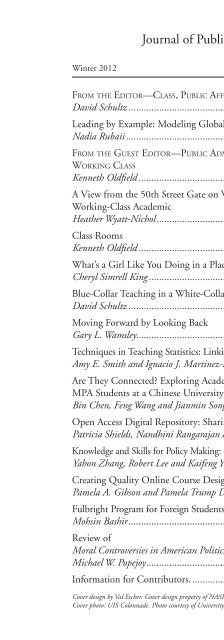WINTER 2012 - National Association of Schools of Public Affairs and ...
WINTER 2012 - National Association of Schools of Public Affairs and ...
WINTER 2012 - National Association of Schools of Public Affairs and ...
Create successful ePaper yourself
Turn your PDF publications into a flip-book with our unique Google optimized e-Paper software.
FROM THE EDITOR<br />
FROM THE EDITOR—CLASS, PUBLIC AFFAIRS, AND HIGHER EDUCATION<br />
The Occupy Wall Street movement has brought into stark focus the reality<br />
<strong>of</strong> class in America with slogans that refer to the “Other 99%.” Similarly, a host<br />
<strong>of</strong> recent Census Bureau <strong>and</strong> other studies point to the dramatic widening <strong>of</strong><br />
income gaps <strong>and</strong> expansion <strong>of</strong> poverty in America.<br />
The 2010 Census reported that the richest 5% <strong>of</strong> the U.S. population<br />
accounted for 21% <strong>of</strong> the income, <strong>and</strong> the top 20% received over 50% <strong>of</strong> the total<br />
income in the country. Compare these numbers to the bottom quintile, which<br />
accounted for about 3% <strong>of</strong> the total income. Congressional Budget Office research<br />
found that the income gap between the top 1% <strong>of</strong> the population <strong>and</strong> everyone<br />
else has more than tripled since 1973. After-tax income for the top 1% increased<br />
by 281% between 1973 <strong>and</strong> 2007; for the middle class or middle quintile, it<br />
increased by 25%; <strong>and</strong> for the bottom quintile, the increase was merely 16%.<br />
Looking beyond income to wealth, the maldistribution has not been this bad<br />
since the 1920s. According to the Institute for Policy Studies, in 2007 the top 1%<br />
controlled almost 34% <strong>of</strong> the wealth in the country, <strong>and</strong> half <strong>of</strong> the population<br />
possessed less than 3%. The racial disparities for wealth mirror those <strong>of</strong> income.<br />
Studies such as the Survey <strong>of</strong> Consumer Finances by the Federal Reserve Board<br />
have similarly concluded that the wealth gap has increased since the 1980s.<br />
Social mobility in America has ground to a halt. A 2010 Organization for<br />
Economic Cooperation <strong>and</strong> Development study found that social mobility in the<br />
United States ranked far below that <strong>of</strong> many other developed countries. Other<br />
studies, including those in 2005 <strong>and</strong> 2010 from the Economist, similarly point to<br />
declining social mobility in the United States that makes it difficult for individuals<br />
to elevate their socioeconomic status. In fact, there is better than a 95% chance<br />
that children will not improve their socioeconomic status in comparison to their<br />
parents. Finally, the latest Census figures point to a poverty rate in 2010 <strong>of</strong> 15.1%,<br />
representing a record 46 million people in poverty. The numbers are equally grim<br />
for women, children, <strong>and</strong> people <strong>of</strong> color in poverty—all record or near record<br />
numbers. Few really can move on up to live the American Dream.<br />
These studies point to a new reality in America <strong>and</strong> public administration.<br />
But class <strong>and</strong> economic issues dominate not just the American public policy<br />
scene, as potential sovereign defaults across many countries in the European<br />
Union demonstrate. This issue <strong>of</strong> JPAE features a special symposium on class<br />
<strong>and</strong> public administration that focuses especially on higher education, the<br />
pedagogy <strong>of</strong> public affairs, <strong>and</strong> how NASPAA should respond.<br />
Incoming NASPAA president Nadia Rubaii (<strong>and</strong> my fellow alumnae<br />
from Binghamton University) presents her inaugural address in “Leading by<br />
Example: Modeling Global <strong>Public</strong> Service Excellence.” She articulates six guiding<br />
principles for her term, noting global challenges, diversity, <strong>and</strong> st<strong>and</strong>ing together<br />
as important values that will direct the coming year. She also announces that<br />
NASPAA will begin strategic planning to equip the organization to fulfill her<br />
principles <strong>and</strong> meet the challenges she foresees for public affairs teaching.<br />
ii Journal <strong>of</strong> <strong>Public</strong> <strong>Affairs</strong> Education

















